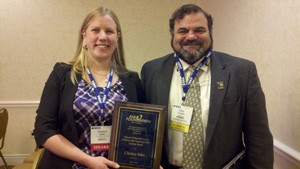
UC Engineering Student Receives Prestigious AIAA Graduate Award
Chelsea Sabo, from the University of Cincinnati's School of Aerospace Systems, has earned the prestigious American Institute of Aeronautics and Astronautics' (AIAA) Foundations Graduate Award, titled as the "Dynamic Pickup and Delivery Problems with Cooperative UAVs Graduate Award." The award provides Sabo a $5,000 grant to further her research. This is the second consecutive year she has been recognized by AIAA for her graduate studies.
Sabo began her studies at UC earning a master of science in aerospace engineering with a thesis titled "UAV Two-Dimensional Path Planning in Real-Time using Fuzzy Logic." She is currently working towards her doctoral degree in aerospace engineering. Her dissertation topic is based on the allocation of unmanned aerial vehicles with communication constraints.
I chose UC for its great educational and research opportunities. As a graduate student, quality of the research and professors is key in choosing a good university. Since arriving, Ive worked closely with my advisor and have had the opportunity to essentially build and maintain a lab from scratch. I credit my opportunities to UC bringing in young, motivated and innovative professors and providing them the resources that allow them to explore, grow, and expand in their work. If not for my advisor, Dr. Kelly Cohen, I wouldnt be nearly as successful in my graduate career!
Sabos current research focuses on the allocation of multiple UAVs (Unmanned Aerial Vehicles) considering communication constraints. The current state of technology ignores communication constraints and requires an operator(s) to allocate and pilot UAVs. In reality, communication can be restricted by line-of-sight, by maximum communication ranges or a need for uninterrupted transmission, states Sabo.
Currently, UAVs have their largest use within military applications and historically UAVs were simple drones (remotely piloted aircraft), but as time progressed, independent UAVs became more commonly used. The significance of addressing these problems is great, as UAVs are increasingly being used in so many areas like armed military attacks, aerial surveillance, scientific research, oil-mineral-and gas exploration, search and rescue, transport, and commercial remote sensing.
She describes, One important aspect of this problem is having an allocation algorithm that can operate in a dynamic setting; as most of the scenarios involve requests that pop-up as the mission evolves and that need servicing immediately.
To give a better understanding of her research and the problems that arise when taking communication constraints into consideration she says, Were going from the assumption that no matter where the vehicles are they are able to communication freely, to the assumption that they can only communicate if they are close enough to each other (their communication ranges overlap). Its been shown in the past that if UAVs work together (i.e. they share information), they can be more efficient.
Sabo uses a specific structure when approaching her research. She first takes into consideration one specific extreme case: UAVs work completely independently to accomplish their tasks. She then uses that information and compares it to another extreme case: UAVs stay in constant contact with each other. Through this method she hopes to find compatibilities across methodologies.
Through her research she has also come upon some difficult questions and issues. What information should the UAVs share? How often should they share their data? If they are going to share information, where and when are they going to meet to do so? Should they stay in constant contact with each other? Should the UAVs work together as a group or should the UAVs work independently? Sabo realizes the challenges in answering these complicated questions, but is not intimidated by them. She views them as opportunities for further areas to explore.
The AIAA award that Sabo received was on just one specific aspect of the problem - how to go from static scenarios (when everything is known) to dynamic scenarios that require self-sufficient, on-demand decision-making.
AIAA was founded in 1963 by the merger of the American Rocket Society (founded in 1930 as the American Interplanetary Society), and the Institute of the Aerospace Sciences (established in 1933 as the Institute of the Aeronautical Sciences). AIAA is the worlds largest technical society dedicated to the global aerospace profession, with more than 35,000 individual members and 90 corporate members. With its commitment to math, science and technology education, the AIAA seeks to address the professional needs and interests of the past, current, and future aerospace workforce and to advance the state of aerospace science, engineering, technology, operations, and policy to benefit our global society.
Related Stories
Inaugural 1819 Innovation Hub Awards honor DAAP grads
May 10, 2024
The University of Cincinnati’s 1819 Innovation Hub gave its inaugural DAAPworks innovation awards to spring 2024 graduates of UC’s College of Design, Architecture, Art, and Planning.
New AI tool assesses risk of self-harm
May 9, 2024
An assessment tool that leverages a powerful new artificial intelligence was able to predict whether patients exhibited suicidal thoughts and behaviors using a quick and simple combination of variables.
UC researchers develop speech therapy video game
May 7, 2024
With ultrasound and a video game featuring a goat on roller skates, researchers at the University of Cincinnati are developing methods to help children overcome difficulties in pronouncing certain sounds, including the difficult “R.”
